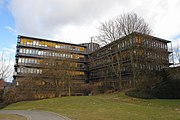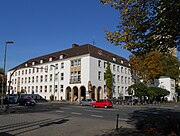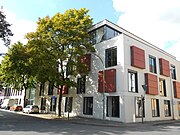University of Osnabrück
| University of Osnabrück | |
|---|---|
| founding | 1629 and 1632/1974 |
| Sponsorship | state |
| place | Osnabrück |
| state |
|
| country |
|
| president | Susanne Menzel-Riedl |
| Students | 13.903 (WS 2019/20) |
| Employee | 1,750 (2019) |
| including professors |
213 (2019) |
| Annual budget | EUR 153.9 million (2018) (global country allocation, third-party and special funds and tuition fees) |
| Networks | Network of medium-sized universities |
| Website | www.uni-osnabrueck.de |
The University of Osnabrück is a public university in Osnabrück , Lower Saxony .
It has existed since 1974 and emerged in its current form from a pedagogical university , the Adolf Reichwein University , which has had its headquarters in Osnabrück Castle since 1953 .
The research focuses on a large number of interdisciplinary courses that are only offered at a few German universities or that are only available in this form in Osnabrück. These include, for example, tax sciences (LL.M. Taxation), applied systems science and cognitive science . Central interdisciplinary institutions are the Institute for Migration Research and Intercultural Studies (IMIS), the Interdisciplinary Institute for the Cultural History of the Early Modern Era and the Institute for Finance and Tax Law.
Since 1999, the German Research Foundation (DFG) has been funding a special research area in the field of membrane proteins, with which the university is represented in cutting-edge biological research. With the Cognitive Science study program, the University of Osnabrück has opened up an internationally recognized research area. The European Legal Studies Institute is also one of the most important research institutions in Europe when it comes to comparative law and legal standardization. Several graduate schools and an international doctoral program in physics support the young scientists. The botanical garden offers both scientists and students excellent working conditions.
Departments
After the formerly independent departments 1 ( social sciences ) and 2 ( cultural and geosciences ) were merged into a new department in 2015, the following nine departments are now based at the University of Osnabrück:
- Faculty 1 Cultural and Social Sciences
- Faculty 3 Education and Cultural Studies
- Faculty 4 Physics
- Department 5 Biology / Chemistry
- Faculty 6 Mathematics / Computer Science
- Faculty 7 Linguistics and Literature Studies
- Faculty 8 Human Sciences
- Department 9 Economics
- Faculty 10 Law
history
The University of Osnabrück, established in 1974, referred to the Jesuit University , also called "Academia Carolina Osnabrugensis", founded in 1629 and 1632 by Wittelsbacher Franz Wilhelm von Wartenberg in Osnabrück . This emerged from the Carolinum grammar school . The Osnabrück foundation initially took over the university coat of arms from the Jesuit University, which was changed to remove the halo from the Christian figures depicted. Since 1953 the Adolf-Reichwein-Hochschule existed in Osnabrück as a pedagogical college (PH). It was integrated into the Lower Saxony University of Education as the Osnabrück Department in 1969 and merged with the University of Osnabrück in 1974. Same goes for that
- 1970: Establishment decision of the Lower Saxony state government
- 1973: Organization law for the University of Osnabrück
- 1974: University studies begin in the summer semester
The start-up phase was as controversial as it was before at the University of Bremen . The appointment of the Marxist economist Ernest Mandel was particularly controversial . The traditional term faculty has been replaced by the term department. When it was founded in 1973/74, the Vechta University of Education was dissolved and converted into a location for the University of Osnabrück; it stayed that way until 1995.
Locations
The University of Osnabrück does not have a central campus . Instead, all buildings are primarily distributed over two regions in the city (city center and Westerberg districts ). The central building and administrative seat is the baroque Osnabrück Castle on the edge of the old town , built by the Protestant Prince-Bishop Ernst August I of Braunschweig-Lüneburg in 1667 . Humanities and economics departments as well as the Juridicum are located in the immediate vicinity over the western part of the city center. Natural science, mathematics and human sciences departments are located about 20 minutes' walk away on the "Campus Westerberg". The botanical garden and the Osnabrück University of Applied Sciences are also located there . Until 1995 the now independent University of Vechta belonged to the University of Osnabrück. The name of the Vechta site at that time was "University of Osnabrück - Vechta Department".
University library
The University Library (UB) Osnabrück has around 1.475 million volumes ( monographs , journals and other media), plus over 12,000 e-journals and over 100 online databases. With an acquisition budget of just under one million EUR (plus special funds) per year, around 30,000 new volumes are acquired every year. Each year, around 350,000 books are borrowed and 30,000 interlibrary loan orders are placed by the users of the University Library. The library is divided into four departmental libraries at four locations: Departmental library B for philologies and cultural studies, departmental library G for social sciences, departmental library J / W for law and economics and departmental library N for natural sciences. Libraries B, G and J / W are centrally located in the city center, while departmental library N is located on the Westerberg . Students of the University and the University of Applied Sciences Osnabrück and teachers, students and residents of the city and the region Osnabrück offers the can UB avail. For this you need a user ID, which can be purchased for a one-time fee of 5 EUR (as of 2012). In addition to the media mentioned, around 700 workstations, individual and group rooms, PC workstations for research and newspaper reading rooms are also available to users.
Partner universities
The University of Osnabrück, like many universities in Germany, maintains contacts with other universities around the world. In total, the university and the various departments have more than 90 partner universities in Europe, Asia, America, Oceania and Africa. In addition to joint research projects, the main focus is on the exchange of students and scientists.
President of the University of Osnabrück
| Surname | Term of office |
|---|---|
| Heinz-Dietrich Doebner | Acting Rector 1973–1974 |
| Manfred Horstmann | Acting Rector 1974–1975 Rector 1975–1979 President 1979–1990 |
| Rainer Künzel | President 1990-2004 |
| Claus Rollinger | President 2004–2013 |
| Wolfgang gap | President 2013–2019 |
| Susanne Menzel-Riedl | President since 2019 |
Until 1979 the official title of the head of the University of Osnabrück was rector , then president .
Composed student body
As part of a public corporation is the Authored student body as part of the student government representing all enrolled students against the university, the university management and the public.
The student body elects the student council once a year , which elects the general student committee .
Student council
- Little rascals - left university group: 5
- Juso & Independent University Group : 5
- Green university group : 11
- Fun and socializing: 6
- The PARTY university group: 4
- European-Oriented Study Group: 2
- Islamic Student and Academic Association: 3
- Liberal University Group : 2
- Young Union University Group : 7
- Student council coordination conference: 4
In the election to the student council from January 17-19, 2017, 2,232 of 14,449 eligible students took part. The voter turnout was 15.4%, 4.4 percentage points above the turnout in the previous election in December 2015. Nine lists competed for the 45 seats on the student council, with the Junge Union University Group , the Liberal University Group , the Islamic Student Group and Akademikerbund, the Juso & Independent University Group, Fun and Sociability and the Little Rascals - Left University Group again, while the PARTTEI University Group and the European-Oriented Study Group competed for the first time. Htw + friends did not take part in this election.
In addition to the 45 directly elected representatives, the student council consists of four delegates from the student council coordination conference.
General student committee
The student council has elected the following speakers:
| presentation | Surname | list | |
|---|---|---|---|
| Finance Department | Kevin Diercks | Juso HSG | |
| Department for Social Affairs | Rabea Mette | Green HSG | |
| Public Unit | Wiebke Glaw | ||
| Department for Culture | Felix Siebert | SpuG | |
| Presentation for students at the Westerberg | Eric Lanfer | ||
| Department for media and technology | |||
| Department for Political Education | Nils Bauer Benjamin Theen |
SpuG |
|
| Department for General Affairs of the Student Union | Laura Boese Lukas Diekmann Özlem Etdöger Philipp Neubarth |
Juso HSG |
|
| Department for Transport and Ecology | Marius Brockmöller Daniela Hermes |
||
| Department for student councils | Christian Freericks | ||
Autonomous units
At the University of Osnabrück there are three autonomous lectures, the speakers of which are directly elected by the students they represent.
- Autonomous gay * lecture
- Autonomous unit for lesbians * and other women *
- Autonomous unit for foreign students
Awards
Basic certificate 2008 "audit family-friendly university"
On April 28, 2008, the University of Osnabrück was awarded the “Basic Certificate 2008 audit family-friendly university” by the berufundfamilie non-profit company . The aim of the auditing and certification is to attract the best minds in the country through a family-conscious university. So far, among others, the were working group "Studying with Children", the initiative group child care, two day care centers and many other important institutions founded and created measures. On December 15, 2017, the University of Osnabrück received the certificate for the fourth time in a row after a successful re- audit .
Images of the university buildings
The building of the Geography and the Institute for Migration Research (IMIS) is located near the castle.
Well-known professors and graduates
Here is a list of well-known current and former professors and graduates.
Professors
Well-known graduates (selection)
- André Berghegger (* 1972), German politician (CDU) (student of law)
- Ulf Buermeyer (* 1976), German lawyer and chairman of the Society for Freedom Rights (student of law and psychology)
- Silvia Breher (* 1973), German politician (CDU) (law student)
- Engin Fırat (* 1970), Turkish football coach (student of sports science)
- Lothar Fischer (* 1955), lawyer (doctorate in law)
- Olaf Fritsche (* 1967), German writer (student of biophysics)
- Helmut Gels (* 1952), Mayor of Vechta (student of law)
- Thomas Gerdiken (* 1960), German pianist and singer / honorary citizen of the city of New Orleans (student of music and geography)
- Stefanie Hiekmann (* 1990), German food journalist and cookbook author (student of social sciences)
- Natalie Hof Ramos (* 1986), German presenter and poker player (student of education and theology)
- Heinz Rudolf Kunze (* 1956), German writer and rock singer (student of German and philosophy)
- Oliver Lowin (* 1974), German politician (SPD) (student of law)
- Krešimir Matijević (* 1975), German ancient historian (student of history and German studies)
- Hubert Müller (1936–1995), German Catholic theologian (student of philosophy and Catholic theology)
- Bernd Schlömer (* 1971), German politician (FDP, former chairman of the Pirate Party) (student of social sciences)
- Martin Schwanholz (* 1960), German politician (SPD) (student of economics and social sciences)
- Wolfgang Spickermann (* 1959), German ancient historian (student of philosophy and Catholic theology)
- Michael Timme (* 1971), Professor (student of law)
- Rainer Werning (* 1949), publicist (student of social sciences)
- Christian Wulff (* 1959), German politician (CDU) and 10th Federal President of the Federal Republic of Germany (student of law)
See also
Web links
Individual evidence
- ↑ “Making knowledge socially available” - Prof. Menzel-Riedl moves to the top of the University of Osnabrück - youngest university president in Germany. Retrieved September 30, 2019 .
- ↑ Figures / data / facts about the University of Osnabrück , accessed on December 28, 2019
- ↑ a b c Figures / data / facts about the University of Osnabrück , accessed on December 28, 2019
- ↑ Further information can be found under: Subject areas . Last updated: May 8, 2015.
- ^ Report in Die Welt on July 17, 1975, page 3: "The subject course is canceled"
- ↑ www.uni-vechta.de: History of the University of Vechta. Retrieved May 25, 2017 .
- ↑ Further information can be found at: Site plan of the university buildings . As of May 8, 2015.
- ↑ Brief introduction to the University Library (PDF; 882 kB), accessed on January 10, 2009.
- ↑ Compare also: partner universities . Last updated: January 28, 2008.
- ^ The university in numbers: leaflet with information about the University of Osnabrück, 2016.
- ↑ Official final result of the elections to the organs of the student body of the University of Osnabrück from January 17 to 19, 2017 ( Memento from March 16, 2017 in the Internet Archive ) from February 2, 2017 on www.stura.uni-osnabrueck.de (pdf)
- ↑ Results of the StuRa election December 2015
- ↑ AStA May 2016
- ↑ www.beruf-und-familie.de (PDF; 104 kB), from April 28, 2008.
- ↑ University press release of December 21, 2017
Coordinates: 52 ° 16 '22.7 " N , 8 ° 2' 30.4" E










